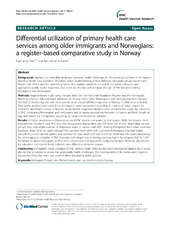| dc.description.abstract | Background: Aging in an unfamiliar landscape can pose health challenges for the growing numbers of immigrants and their health care providers. Therefore, better understanding of how different immigrant groups use Primary Health Care (PHC), and the underlying factors that explain utilization is needed to provide adequate and appropriate public health responses. Our aim is to describe and compare the use of PHC between elderly immigrants and Norwegians. Methods: Registry-based study using merged data from the National Population Register and the Norwegian Health Economics Administration database. All 50 year old or older Norwegians with both parents from Norway (1,516,012) and immigrants with both parents from abroad (89,861) registered in Norway in 2008 were included. Descriptive analyses were carried out. Immigrants were categorised according to country of origin, reason for migration and length of stay in Norway. Binary logistic regression analyses were conducted to study the utilization of PHC comparing Norwegians and immigrants, and to assess associations between utilization and both length of stay and reason for immigration, adjusting for other socioeconomic variables. Results: A higher proportion of Norwegians used PHC services compared to immigrants. While immigrants from high-income countries used PHC less than Norwegians disregarding age (OR from 0.65 to 0.92 depending on age group), they had similar number of diagnoses when in contact with PHC. Among immigrants from other countries, however, those 50 to 65 years old used PHC services more often (OR 1.22) than Norwegians and had higher comorbidity levels, but this pattern was reversed for older adults (OR 0.56 to 0.47 for 66-80 and 80+ years respectively). For all immigrants, utilization of PHC increased with longer stay in Norway and was higher for refugees (1.67 to 1.90) but lower for labour immigrants (0.33 to 0.45) compared to immigrants for family reunification. However, adjustment for education and income levels reduced most differences between groups. Conclusions: Immigrants’ lower utilization of PHC services might reflect better health among immigrants, but it could also be due to barriers to access that pose public health challenges. The heterogeneity of life courses and migration trajectories should be taken into account when developing public policies. | en_US |

